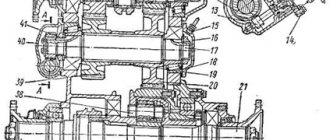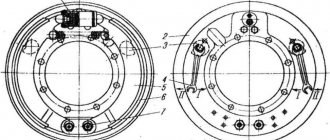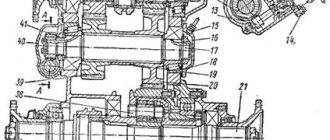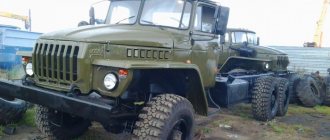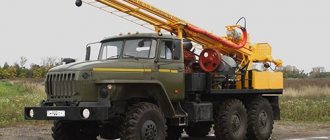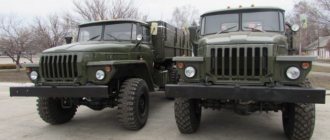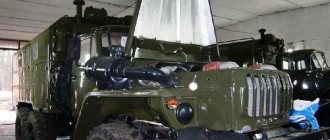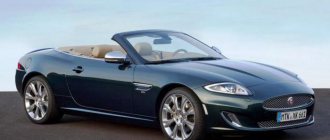01-Ural-NEXT_zr-09_15
Ural Next. From 2,794,000 rubles.
Where to take your first test drive of a rugged four-wheel drive truck? Of course, where there are really no roads - in the Ural Mountains! The places near Yekaterinburg are beautiful, almost like Switzerland. Although it looks like Karelia: dirt and rocky forest roads, steep climbs strewn with boulders. In the lowlands there are streams and rivulets, and even swamps. For trucks of all generations, the Ural is their native habitat. I was rushing along a forest road in sixth gear (out of nine possible), out of habit I slightly exceeded the speed and did not see the bump across the track. The Ural literally jumped out on it. If the seat didn't have air suspension, I wouldn't envy myself.
Then the blue sky behind the glass quickly gave way to the prospect of such a rut filled with rainwater. Bang! Thick spray covered the hood, windshield and even the doors. The water mixed with silt and sand completely deprived the view. Almost blindly, at a speed of sixty, I fly a half-destroyed log deck across a stream. The road rises again, and I manage to turn on the windshield wipers...
We crawled over slippery boulders and stormed steep slopes, overcame fords and tried to “break” the rear suspension balancers in gullies. And yet this cannot be called a serious test - just a fleeting acquaintance. But 25–30 kilometers along heavy forest roads showed that the ennobled Ural Next has not lost its main properties - all-terrain capability.
02-Ural-NEXT_zr-09_15
A well-thought-out workplace in a unified next-cab will certainly appeal to drivers.
A well-thought-out workplace in a unified next-cab will certainly appeal to drivers.
A well-thought-out workplace in a unified next-cab will certainly appeal to drivers.
STAGES OF THE DIFFICULT PATH
The current update of Miass trucks is taking place in two stages. At the first, the Urals received a new engine, transmission, units and some components - in particular, a pneumatic braking system instead of a pneumohydraulic one and a different steering mechanism. Such vehicles are called Ural M, and they can be either with the classic Ural-375/4320 cab or with the licensed cabover Iveco TurboStar (cabin P, “pi”). If a cab from Gazelle Next is installed on the Ural M chassis, then this is already Ural Next - and, therefore, the second stage of modernization has been completed.
The engine is YaMZ-536 with a volume of 6.65 liters, the most modern domestic turbodiesel. The new Yaroslavl YaMZ-530 family consists of four- and six-cylinder engines developed jointly with the Austrian engineering company AVL List GmbH. The last digit in the engine index indicates the number of cylinders. Now a new plant in Yaroslavl produces about two dozen modifications of the YaMZ-536 engine, including a gas version. The expansion of production volumes is facilitated by the widespread unification of the YaMZ-536 with the four-cylinder diesel engine YaMZ-534, which is installed on Lawn Next, GAZ-3309, and PAZ buses.
The design of the engine is typical for modern diesel engines in the “liter per cylinder” segment: the cylinder block and the common head with four valves per cylinder are cast from cast iron, the liners are replaceable wet, the timing drive is located on the flywheel side. Turbocharging, intercooler, Common Rail power system with a rail pressure of 1800 bar for the Euro 4 version. Compliance with Euro-3 and Euro-4 standards is achieved using the most modern version of the EGR system - with liquid cooling of the exhaust gases mixed with a fresh air charge. The EGR system can be supplemented with a particulate filter, but this is in the future (Euro 5 level). So far, Yaroslavl engineers have decided not to use AdBlue urea solution on their new in-line engines, and for the Urals in Russia, as for all-terrain vehicles, recirculation is not needed.
Ural-NEXT raid
Text and photo: DALNOBOI.ORG
An orderly row of multi-colored cabins hid behind their “backs” a wide selection of superstructures: a rotation bus, a dump truck with a body of its own production, a cargo-passenger vehicle, a truck tractor with a CMU, a truck crane and a green van on a long-wheelbase chassis with a double-row cab.
Last year it was a mysterious place called Devil's Settlement, in 2016 we are again in the hospitable Urals, in the vicinity of the famous Berezovsky mine. To begin with, I suggest going through the hardware and refreshing your memory about the history of the creation of the new model. The first-born in this NEXT family of the same name of the GAZ group was the famous semi-truck "Gazelle", the lineage continued with the medium-duty truck "Lawn", which replaced the GAZ-3307 and 3309, and now a heavy off-road truck with a hood arrangement named Ural was born.
The appearance of the new Miass model was preceded by serious work on deep modernization of already well-known and long-produced models. The main objective of the work carried out was the elimination of long-outdated and (or) unreliable technical solutions while maintaining the basic concept and architecture of the basic Ural brand vehicles. First of all, the trucks received a modern pneumatic braking system instead of a pneumohydraulic one and new power units from the Yaroslavl plant, also part of the GAZ group.
Also, during the modernization process, a new imported integral type RBL steering mechanism appeared, and the transmission and chassis were revised to increase the strength, reliability and durability of the main components, increasing the declared resource to 350,000 km (manufacturer’s data). Now, after the final stage of modernization, the truck has received a new cabin with a unified “living” module and a new plastic tail. This decision to unify the GAZ group with the younger families of trucks was by no means accidental and became the cause of numerous disputes.
On the one hand, the unification of body panels reduces the cost of production, but does everything fit so well from a light-duty truck to a huge all-wheel drive truck? As a result, time will tell how justified this decision is - long-term operation will not leave any chance for any significant shortcomings to remain in the shadows. For now, we can only complain about the following: the lack of a handrail on the front pillars of the cab - the height from the ground is about 75 cm and you need to climb with a certain effort, there is also a gearbox control lever, which can be like the old Yaroslavl "five-speed" or ZF brand, sometimes when switching rests against the front panel, and the mirror stands need a slightly different shape.
But the plastic tail of the cabin is beyond praise and a source of pride for the Urals - neither a sledgehammer, nor stones, nor a potato gun has yet been able to break or at least crush the hood, wings and some other panels. Pass!
The plastic tail of the cabin is beyond praise and a source of pride for the Urals - neither a sledgehammer, nor stones, nor a potato gun has yet been able to break or at least crush the hood, wings and some other panels
Engine and so on
The new family of Yaroslavl engines consists of 4 and 6 cylinder diesel engines developed jointly with the Austrian engineering company AVL List GmbH. The last digit in the engine name indicates the number of cylinders. An important advantage of an engine for an all-terrain truck is its weight. YaMZ-536 weighs 640 kg, the old V-shaped diesel YaMZ-236 weighed 1050 kg, for comparison, the engine of the base KAMAZ-740 weighs in unison with its index - 740 kg.
An empty all-wheel drive truck with a heavy diesel engine tends to dig into the front axle on soft soils, but a loaded all-terrain vehicle also doesn’t need an extra couple of hundredweight. Our test vehicles had in-line sixes: a truck tractor with a CMU and a dump truck with a maximum “civilian” power setting of 312 “horses” at 2300 min-1 and a torque of 1240 Nm, a utility vehicle with a booth behind the cab was converted to work on methane and produced 260 hp, and its maximum torque was 1100 Nm at a range of 1300 - 1600 min-1.
Under the hood is the YaMZ engine of the new 536 family, converted to run on methane, which is why it received forced ignition; the photo clearly shows individual ignition coils for each cylinder and spark plug tips on high-voltage wires.
The truck crane, the shift bus and the “fuel barrel” were content with average power settings with herds of 240 or 285 horses. But it was not by chance that I started talking about citizenship. No, we won't talk about military vehicles this time. The beautiful green van that was present in our test is nothing more than a racing vehicle for rally raids. Therefore, there the engine already develops 330 hp, the cleanliness of the processing of gears in the transmission has been increased, the gear ratios and completely different axle shafts in the drive axles have been changed.
It is gratifying that the Ural Automobile Plant is trying itself in this form, because the experience gained in motorsport is invaluable. But let's return to our Urals, or rather to their engines. So, the design is typical for today in this segment: a block and a common cylinder head with four valves per cylinder made of cast iron, the timing drive is located on the flywheel side. The power system is Common Rail, the rail pressure is 1800 bar for the Euro-4 version, and all-terrain vehicles don’t need more yet.
As it is written in the owner's manual, “the vehicle is designed for driving on all types of roads and terrain.” So, when you see this very area with your own eyes, it seems that it is absolutely impossible for any car to drive here. On the contrary, factory test drivers claim that for their factory products it’s just a walk in the park...
An important design feature of this engine is the standardized SAE1 flywheel housing, which makes it possible to install various gearbox options. As already mentioned, today the plant installs two options. This is YaMZ or ZF Ecomid 9S1310TO from Naberezhnye Chelny. The first budget and very antique option, according to the factory workers, is addressed to customers, where the base chassis is only required to arrive at the site of operation of the superstructure equipment.
The second, modern version has 8 gears, plus one “creeping” and reverse gear. The ZF Ecomid gearbox allows operation with a maximum engine torque of 1300 Nm, allowing the vehicle to work in difficult operating conditions or with a trailer. In general, thanks to the two-stage transfer case, the driver of the “next” Ural now has as many as 18 gears in his arsenal! An excellent choice, and also two inter-wheel locks on the rear bogie and one inter-axle one. Serious off-road challenge! The declared life of the drive axles is 350,000 kilometers with a rated torque of up to 4120 Nm.
"Chassis" and layout
Purely externally, the chassis of the new Ural-NEXT remained without fundamental changes in relation to the “old times”, which trace its history back to the base model Ural-375. You won’t see with the naked eye how the updated bridges have been given a margin of safety and their load-carrying capacity has been increased, and the manufacturing technology of the frame and its components has been improved. The new model has one-piece frame reinforcements, the parts themselves received cataphoretic priming and powder painting.
Purely externally, the chassis of the new Ural-NEXT remained without fundamental changes in relation to the “old times”, which trace its history back to the base model Ural-375. You won’t see with the naked eye how the updated bridges have been given a margin of safety and their load-carrying capacity has been increased, and the manufacturing technology of the frame and its components has been improved. The new model has one-piece frame reinforcements, the parts themselves received cataphoretic priming and powder painting.
When designing the new product, the designers slightly changed the geometric layout of the frame, moving the engine back by 200 mm. The rearrangement, which caused a change in the wheelbase, became the subject of fierce debate between designers who wanted to further improve the legendary cross-country ability of the Urals and marketers who wanted to maintain the basic parameters of the chassis in order to avoid complications when installing familiar add-ons on the new model.
In the end, they decided not to complicate the lives of manufacturers of bodies and special equipment, and not to change supplier partners, otherwise the development of a new model could be unacceptably delayed for too long, although it is not so easy to find a competitor to the Urals, the market dictates... The decision on suspensions remained traditional, but not without updates: as before, there are longitudinal semi-elliptical springs and balancers, inter-axle blocking is provided, but now it is also possible to block the cross-axle differentials of the middle and rear axles.
The brake mechanisms of all wheels, traditionally, are drum, but now there are pneumatic components of the Wabco braking system instead of the outdated pneumohydraulic ones that caused a lot of criticism. It is also worth noting that in addition to the first pre-production samples with a 6x6 wheel arrangement, provided for testing a year ago, 4x4 versions and trucks with a double cab are already being produced in full swing in Miass.
Eh, I'll give it a ride!
As it is written in the owner's manual, “the vehicle is designed for driving on all types of roads and terrain.” So, when you see this very area with your own eyes, it seems that it is absolutely impossible for any car to drive here. And factory test drivers, on the contrary, claim that for their factory products it’s just a walk... It’s good that at least the Grammer driver’s seat is pneumatic, otherwise it would shake not only the soul out of me...
But the passenger does not have such luxury, it’s hard for the poor guy... The speed is from five to twenty-five kilometers per hour, but we are persistently and confidently moving forward! The steering column is currently adjustable only by tilt angle, but the tilt of the front pillars partially overlaps the rear-view mirrors, and if you increase the reach of the steering column and move back a little, this inconvenience can be avoided.
New front optics, in the pre-production sample the upper block was of an indefinite model, today the unit is certified and includes daytime running light, turn signal and marker. The workplace in a unified cabin module for a heavy truck is perceived positively, but in a two-row cab the gallery is a bit cramped.
To control the transmission in the cab there is only one floor lever, and without flags or toggle switches. For the 9-speed ZF gearbox, the “2H” scheme is used, the Yaroslavl 5-speed gearbox is completely content with a simple scheme, similar to a “passenger car”. The clutch pedal and response to the accelerator in all cars provided for testing have their own character, and quite different. The “middle peasants”, with a power of 240 and 285 hp, have the most adequate efforts and strokes.
The engine of the “green van” (330 hp at 2500 rpm, 1300 Nm at 1300 - 1600 rpm) is perceived as “superior”. You release the clutch, let's go, now you can smoothly return the pedal to its original position, and at this moment the car rushes forward, as if by mistake it had turned on too high a gear. The gas engine, on the contrary, “wonders” with the right pedal. There is enough traction and elasticity throughout the entire range, but you need to “play” at “filling the cylinders.”
In the photo: Konstantin Zakurdaev, editor-in-chief of the magazine “Special equipment and commercial transport”
You keep the right pedal in a constant middle position, but you can’t achieve uniform movement; after a while the revolutions begin to increase on their own. Having got used to it a little, you adapt to reduce the gas in advance, but you need to choose the right amount of inertia correctly. Engineers say that the engine is completely new and requires fine-tuning and tuning, we have the very first methane cars in our hands, well, okay then!
The brake pedal puts the car on hold - there is clearly too little free play, but judging by the differences in this parameter on different test units, this is just a matter of adjustment. In general, the pedal assembly is familiar from the Gazelle and there are no complaints about it. Control of blocking and centralized tire inflation is electro-pneumatic, using buttons. The effort on the steering wheel, despite the unusually small diameter, is minimal, but the steering does not suffer from a lack of information content, especially considering the huge bast tires, which are presented in three versions.
Omsk “O-184” with dimensions 425/85R21 or “Kama-1260” with dimensions 14.00-20, and on the flying hound premium “Michelin” with dimensions 14.00R20. All types of tires behave differently. Omsk ones cling better to sticky soil, but are noisy, Kama ones showed better performance with increasing speed, imported ones are too expensive for a hard-working, not a sports car.
He and not him
The silhouette lines of the new cabin continue the stylistic traditions of its recognizable and legendary predecessor.
We discussed all these issues with our colleagues and at the same time “broke” the rear balancers, underwent dimensional training among natural obstacles in the form of trees, and then returned to the hotel along the usual road in the general flow. At that time we were sitting in a cozy cabin, turning the tiny and light steering wheel and even listening to a frightening weather forecast on the radio, which spoke of an abnormal 40-degree heat this summer in the Ural Federal District. But the factory workers firmly assured that air conditioning will appear as an option in a couple of months.
In general, this is no longer the same associative “Ural” - an ascetic army truck, well, except when you look at the ride height and dimensions in the mirror. Thanks to the common cabin module, it feels like it’s just a completely comfortable new Gazelle that has unexpectedly grown in size, or maybe a “Lawn”, if not for the noise of the transfer case as the speed increases.
Background information on the Ural-NEXT vehicle
in some figures (manufacturer's data)
The warranty for the new model, according to factory workers, will be 2 years or 100,000 km; scheduled maintenance must be carried out every 15,000 km. The average cost of ownership, according to preliminary data, will be approximately 20.5 rubles/km, the average operating fuel consumption of this off-road truck is about 38 liters per hundred kilometers. The weight distribution of the new model is close to ideal: the front axle accounts for 25% of the vehicle’s weight, and the rear bogie – 75%. The declared life of the drive axles is 350 thousand kilometers with a rated torque of up to 4120 Nm. The new YaMZ-536 engine should operate for 800,000 km until overhaul or replacement. If Ural-NEXT leaves the plant in the form of a chassis, then it is equipped only with the preparation of electrical wiring for the installation of a tachograph, but a solid vehicle, for example, a flatbed tilt truck, receives a tachograph as standard.
Since most of the cars provided for testing are commercial samples, and their specifications are publicly available, in the technical specifications we will provide data for the auto racing and methane versions.
04-Ural-NEXT_zr-09_15
The three tested cars had turbodiesels with the same power setting of 312 “horses” at 2300 rpm and with a torque of 1240 Nm - so far this is the limit for the YaMZ-536. There are weaker versions: 240, 270 and 285 hp, torque from 900 Nm at 1300–1600 rpm. And the shift bus was equipped with a 240-horsepower engine, converted to a gas-diesel cycle (methane plus diesel fuel).
The diesel engine is quiet and without unnecessary vibrations. There is no point in comparing it with the old YaMZ V-shaped “six” - these are different engines. Specific fuel consumption at rated power is 140 g/kWh. And if the YaMZ-236 diesel engine weighs 995–1050 kg, the KamAZ-740 - 743 kg, then the YaMZ-536 weighs only 640 kg.
The flywheel housing has a unified fastening according to the SAE1 standard, which makes it possible to install gearboxes from foreign and domestic manufacturers. I managed to drive a car with a modernized Yaroslavl five-speed gearbox: it is still quite suitable for such add-ons as a truck crane, shift truck or fire truck - that is, for working without a trailer. But the flagship for Ural Next is the nine-speed ZF-Ecomid 9 S 1310 TO, which is produced by the TsF-Kama joint venture in Naberezhnye Chelny. These same ZF boxes are used not only on new models of Kama trucks, but also on heavy versions of medium-duty vehicles, such as DAF LF, Renault Midlum, MAN TGL, Iveco Eurocargo.
Ural 4320 “LESHYY” mobile home (30 photos)
Car Ural 4320 “Leshy” motorhome: photo of car tuning with description.
Craftsman Konstantin Kayko converted his Ural into a comfortable motorhome for off-road travel.
Characteristics of the Ural 4320 car.
- Engine KAMAZ 740.
- Fuel separator for 24V.
- FUSO brakes.
- The cabin is expanded towards the kung by 15 cm, seats from Gelendvagen are installed.
- Air conditioning 24v.
- The kung has 220v air conditioning.
- 2- webasts “wet” and air.
- 2 gas boilers in the galley and shower (Japanese fully automatic).
- Stationary bio-toilet.
- Refrigerator for 12-24-220v.
- Inverter 24=220V 50Hz.
- Gasoline electric generator with remote control from a kung 3 kW 220V 50Hz “Dometik”.
- Water heating from an engine or from a webast.
- Wood stove.
- Batteries 2x190A/h and 2x220A/h (helium).
- Full galley sink and Dometic range hood.
- In the bedroom there is liquid heating of the bed.
- Electrically heated floor.
- Sleeping places 3+1.
- 2 yacht hatches on the roof can support the weight of a person.
- The kung is sheathed in 2 mm corrugated aluminum.
- Kung strapping corner 3 mm made of stainless steel. become.
- Roof rails made of thick-walled stainless steel. pipes.
- Fuel supply 600 l, + two cans with a supply of gasoline for the generator and chainsaw,
- Water supply is 300 liters in winter, 500 liters in summer, water is supplied through a hydrophore.
- Stern mechanical winch.
- Bow electric winch.
- 2 boxes for dry firewood in the rear part of the kung made of 3mm stainless steel.
- Stern ramp with motorcycle mount.
- Xenon overhead light.
- Crankcase and gas tank protection 8 mm steel.
- Additional receiver and electric air compressor.
- Removable crane for loading a rubber boat onto the roof.
- GPS-TV-DVD... height inside the kung is 2m.
We invite you to look at a photo of a tuned Ural 4320.
Fuel consumption, depending on the road surface, is 30-60 liters per 100 km.
Homemade author: Konstantin Kayko. Vladivostok. source
Popular homemade products from this section
Share on social media networks
avto-samodelki.ru
05-Ural-NEXT_zr-09_15
Control unit for the centralized tire inflation system and methane supply.
Control unit for the centralized tire inflation system and methane supply.
Control unit for the centralized tire inflation system and methane supply.
On forest roads in the Urals Next with a ZF gearbox is most convenient to drive with the low gear engaged in the transfer case and on the top row of the box, using gears from fifth to eighth. This box has eight travel gears (four gears in the main box and two ranges provided by a planetary range), one “creeping” and a reverse. The unit is designed to work with engines having a maximum torque of about 1300 Nm, and nine gears allow the vehicle to work in difficult conditions or with a trailer. In combination with a two-speed transfer case, the driver of the Ural Next has an unprecedented choice of 18 gears at his fingertips. The range of gear ratios is from 20.38 to 1.00!
The drive axles have also been modernized. If you remember the Ural-375, then its front axle could withstand a load of 3.8 tons, and the rear bogie accounted for 9.3 tons. Now the front axle can withstand 6.5 tons, and the rear bogie - 16 tons. The load capacity has increased to 12.5 etc. To accommodate the increased torque, the axle shafts and differentials were changed, and now the standard configuration includes inter-wheel locking of the trolley axles. The control of the locks and transfer case is electro-pneumatic, with keys - without rattling levers. The declared service life of the bridges is 350,000 km.
The frame is now more durable, assembled according to the “spar in spar” scheme. It requires cataphoretic priming and powder painting.
Ural 4320: price, technical specifications, photos, reviews, dealers Ural 4320
Odnoklassniki Ural 4320 price
Unfortunately, this model is unique in its price range or is no longer available.
Reviews from owners of Ural 4320
Ural 4320, 1991
I worked on the Ural 4320 a little, I can say that the gasoline and diesel versions differ quite a lot, at least the cabin and wiring are definitely different there, as well as the gearbox. I have decent experience in operating Kamaz engines (except for the latest ones, which are Euro 2, etc.) and YaMZ engines. From personal experience, the Yaroslavl engine is more reliable - it is ancient, but less problematic to operate, it pulls better at the “lower” range, and if there are no factory defects initially, it will work for a long time and reliably with minimal care and maintenance. In the Urals 4320, the YaMZ engine starts better in cold winters than the Kamazovsky one. The downside of this engine is that it is difficult to warm it up to operating temperature in winter, but there are all sorts of tricks to overcome this. There is one more tricky nuance - the Ural 4320 is equipped not with an ordinary Kamaz engine, but with its cunning modification, as was once the case with the ZIL 133GYA, and the difference between them is quite noticeable. I personally would choose the 8-cylinder Yaroslavl engine.
Advantages: reliability. Good YaMZ engines. Patency.
Disadvantages: brakes.
Victor, Troitsk
Ural 4320, 1992
Ural 4320 vehicles have excellent cross-country ability and high-speed performance, both on asphalt and dirt roads. The carrying capacity of this equipment is about 15-17.4 tons, which will pass through snowy forests and off-road, because it has all-wheel drive (6 by 6), the tire configuration provides good traction. Measured weight distribution, as well as excellent maneuverability, ensure the Ural 4320 performs its tasks in any extreme conditions. The conversion technology was developed back in Soviet times, and has a triple safety margin, because its main purpose is to work in the difficult conditions of the far north, forest belt, taiga, off-road, military areas. All units on the Ural 4320 also have wear resistance and unpretentiousness, which allows them to work for a long time without repair or maintenance, which is very important for the above conditions of the tasks performed.
Advantages: endurance. Reliability. Strength. Simplicity of design.
Disadvantages: no serious ones.
Konstantin, Ivanovo
Ural 4320, 1989
The Ural has many more advantages than disadvantages. There are weak points in any car. The main thing is who needs what. The Ural is a strong and fairly reliable vehicle and its cross-country ability is not bad, especially with the 236 engine. The problems that I had to face, as I understand it, are typical for him - the steering gear, the transfer case. And now the brakes require attention. They disinhibit poorly. The cross-country ability of the Ural 4320 is amazing, and the fuel consumption is the same as that of the GAZ-66, the mileage without refueling is twice as much as that of the GAZ, and there were practically no breakdowns during the entire period of operation, nothing serious except torn off inflation hoses. The car turned out to be very reliable and did not let us down, however, when I took it back from storage, I went through it completely, changed all the oil seals and some bearings in the hubs due to rust, the 1989 car was taking its toll.
Advantages: reliability. Patency.
Disadvantages: steering gear. Handout.
Konstantin, Vladivostok
avto-russia.ru
12-Ural-NEXT_zr-09_15
The silhouette of the hood and wings is designed in the same, well-recognized style.
The silhouette of the hood and wings is designed in the same, well-recognized style.
The silhouette of the hood and wings is designed in the same, well-recognized style.
Compared to the Ural M model, the engine is moved back by 200 mm, so the wheelbase has also been increased by approximately the same amount - in order to maintain the overall dimensions of the chassis and the ability to mount the usual superstructures.
The suspension is traditional: semi-elliptic springs and reaction rods on silent blocks in the rear balancer. When the car is empty, it shakes quite a bit, but this is normal for all-terrain vehicles.
The brakes on all wheels are drum, highly unified with previous Urals, but now with pneumatic drive. Wedge expansion mechanisms and Wabco pneumatic equipment were installed. The concept of “taking it from the second pitch” has gone into oblivion: the pedal does not fall to the floor. And if the brake pipe is damaged, the energy accumulators will stop the car.
00-Ural-NEXT_zr-09_15
The steering mechanism is also imported - with an integral hydraulic booster from the German company RBL. Thanks to him and the powerful power amplifier pump, the steering wheel remained small and gazelle-like. The steering gear has non-separable steering tips with an extended service life, and they are replaceable; you don’t have to buy a rod assembly.
UNIFICATION
Remember Ilf and Petrov: “With this half-chair, Master Gumbs is starting a new batch of furniture”? The sacramental phrase was said about the chairs, but it is quite applicable to the next cabin. It is clear that a little later the Ural Next will receive a two-row Gazelle cab with a low roof. And when the production of the all-metal Gazelle Next van is launched in Nizhny, the Urals will certainly get a high roof from it. For now - a simple single-row cabin. The doors open surprisingly easily - the imported locks turned out to be good. There are three steps leading up: the first is suspended (on a cable), the second is the main one, mounted on the frame, and the third is the one behind the door of the Gazelle Next. There are lower handrails in the doorway - quite convenient.
Having climbed up, I was once again convinced that unification is only beneficial for the domestic truck industry. Ural drivers could only dream of such a thoughtful interior with many pleasant little things (bottle containers, niches for documents, a good heater). The driver's seat is from Grammer, with air suspension. These are made in Yelabuga, at the TIS LLC enterprise. The Gazelle does not have an air suspension seat, and it doesn’t need it, but on the Next Lawn I would like to see such a luxurious seat. The passenger sofa is from a Gazelle, and it has no suspension at all. And electric windows are perceived as nothing less than a luxury.
Inherited cabin
The modular cabin made of galvanized steel was inherited from the Gazelle by the Ural Next. This choice was dictated by the need to create a truck with a hooded design that improves safety and ensures unhindered accessibility for repairs under any conditions. But meanwhile, the new Ural has not lost its signature, recognizable elements, such as a metal front with a pronounced radiator grille and powerful wings. The use of impact-resistant polymers gives the car modernity and novelty. The cabin of the car is quite spacious, allowing you to comfortably accommodate several more passengers in addition to the driver. The use of lighting technology from Russian and German manufacturers allows the driver to work unhindered in the dark.
The slope of the windshield, which is unusual for heavy trucks, offers good visibility from the driver’s seat, which cannot be said about its predecessors.
11-Ural-NEXT_zr-09_15
Lensed headlights and LED turn indicators are installed at the front.
Lensed headlights and LED turn indicators are installed at the front.
Lensed headlights and LED turn indicators are installed at the front.
The effort on the steering wheel, despite the unusually small diameter, is small, and the steering does not suffer from a lack of information content - even despite the huge Omsk “bast shoes” O‑184 in size 425/85 R21.
